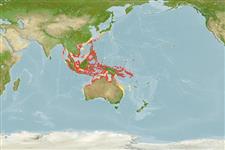Preferred temperature (Ref.
123201): 25.4 - 29.3, mean 28.7 °C (based on 1703 cells).
Phylogenetic diversity index (Ref.
82804): PD
50 = 0.5000 [Uniqueness, from 0.5 = low to 2.0 = high].
Bayesian length-weight: a=0.02344 (0.01134 - 0.04848), b=2.98 (2.80 - 3.16), in cm total length, based on LWR estimates for this (Sub)family-body shape (Ref.
93245).
Trofisk nivå (Ref.
69278): 2.7 ±0.30 se; based on food items.
Resiliens (Ref.
120179): Hög, lägsta populationsfördubblingstid mindre än 15 månader (Preliminary K or Fecundity.).
Fishing Vulnerability (Ref.
59153): Low vulnerability (10 of 100).
🛈
Nutrients (Ref.
124155): Calcium = 98.9 [50.1, 153.4] mg/100g; Iron = 0.726 [0.446, 1.179] mg/100g; Protein = 18.2 [17.1, 19.3] %; Omega3 = 0.111 [0.069, 0.178] g/100g; Selenium = 24.8 [14.1, 45.5] μg/100g; VitaminA = 82.1 [22.8, 275.6] μg/100g; Zinc = 1.66 [1.14, 2.39] mg/100g (wet weight);
